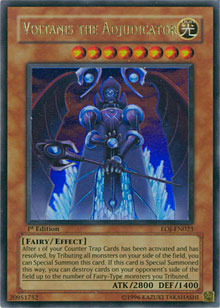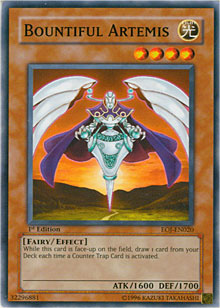
Looking back on these past few weeks, I now realize how much time I put into looking at aggro cards in the Yu-Gi-Oh! TCG. The aggro archetype is so often overlooked that I felt it needed some analysis. What are the perks of running an aggressive deck? How does it benefit you more than control? What must you keep in mind when piloting a deck like that? How exactly does it differ from a control deck?
Forget all of that. I’m so tired of aggro that if I see another copy of Hydrogeddon or My Body as a Shield, I’ll probably bury my head in a pillow and ignore all of my surroundings for the next week. Since I’m a control player at heart, my way of thinking differs quite a bit from an aggro player. I really don’t like having to calculate how to deal damage in the fastest way possible, nor do I care about how to best keep your opponent on guard with my attacks. What I enjoy doing is flipping up Solemn Judgment in response to a timely Heavy Storm, and manipulating my opponent’s actions in order to benefit me most.
So I was obviously jumping for joy when I saw the Counter Fairy line-up in the Enemy of Justice booster set. I enjoy playing decks that involve drawing cards and countering my opponent’s cards much more than sending monsters at my opponent’s face (unless it’s some big monster that can single-handedly win me the game). The Counter Fairies are based solely upon total control of the game. The deck runs like this: you completely ignore your own early game and focus on crippling any early plays your opponent makes. Your counter-trap count is significantly higher than most other decks, and they are used to do something far worse than destroying your opponent’s cards: negating them entirely. This means that Zaborg the Thunder Monarch and Chaos Sorcerer tend to have problems against you, unless they’re played at the right time. All while, you are generating some cycling power (and occasionally some card advantage via activated Solemn Judgment cards) through monsters such as Bountiful Artemis, Layard the Liberator, and on occasion, maybe even Des Lacooda (although the latter is risky, since it might cause you to deck out).
 Your win conditions revolve primarily around Voltanis the Adjudicator, whose effect does not target any cards. This means that the big monster can single-handedly wipe all the cards off of your opponent’s field. Monsters such as Chaos Sorcerer or Soul of Purity and Light tend to work as well, and they combo well with Layard the Liberator (especially Soul of Purity and Light).
Your win conditions revolve primarily around Voltanis the Adjudicator, whose effect does not target any cards. This means that the big monster can single-handedly wipe all the cards off of your opponent’s field. Monsters such as Chaos Sorcerer or Soul of Purity and Light tend to work as well, and they combo well with Layard the Liberator (especially Soul of Purity and Light).
However, the backbone of this deck still falls upon a card-drawing engine that can stabilize the user, along with its counter traps. It is also important to note that this deck is slow. Very slow. Like about as fast as a race between a sloth and a trail of molasses. Why? Because of the counter traps you run. If Sakuretsu Armor is a reactive trap, then counter-traps are like really complicated copies of Sakuretsu Armor. While a trap card like Sakuretsu Armor is simply activated to destroy a monster, counter traps tend to have many points at which they can be activated.
Take Divine Wrath, for example. When you draw this card, the following questions usually come to mind:
—What does my opponent have on his or her field and in the graveyard that could be negated by Divine Wrath?
—If my opponent has a lot of targets, what card could possibly be in his or her deck or hand that I would want to optimally save this card for?
—At what point will I be forced to activate this card?
While Sakuretsu Armor can only be activated in response to an attack, an effect that Divine Wrath can negate might appear at almost any time. Even small and unnoticeable abilities such as Kuriboh can be stopped by Divine Wrath, leaving you with plenty of options as to when to use it. Now add in the fact that you’re running more counter traps just like it, and that you’re also in a 40-minute round. If you don’t know what you’re doing, then things can get ugly. You’ll either blow a counter trap on the wrong card and get crushed, or you’ll spend too much time thinking about how to play your deck correctly and lose the match on time.
 What’s the benefit to running a deck like that? On a personal level, I prefer them because there is almost never a duel that you cannot win . . . meaning that if you lose, you can look back on your game and see if you made any questionable plays. Doing so can dramatically improve how you play in the future, since you can pinpoint what you did wrong. However, the other reason falls on the monsters and win conditions that can generate a ridiculous amount of disruption.
What’s the benefit to running a deck like that? On a personal level, I prefer them because there is almost never a duel that you cannot win . . . meaning that if you lose, you can look back on your game and see if you made any questionable plays. Doing so can dramatically improve how you play in the future, since you can pinpoint what you did wrong. However, the other reason falls on the monsters and win conditions that can generate a ridiculous amount of disruption.
What exactly makes Bountiful Artemis, a staple for the counter-trap-based decks, a necessity? Layard the Liberator is a tough ability to work with, but it provides you with so much raw card advantage (and access to win conditions you remove from play) that it seems like you should focus on that over Bountiful Artemis. Why run the level 4 fairy that is too big to be searched for by anything over Des Lacooda, which effectively allows you to draw two cards per turn?
The answer to all of those questions is simple: Bountiful Artemis provides you with stability and advantage, and also significantly speeds up your deck. In an early game where your opponent has a lot of cards to use against you, Bountiful Artemis allows you to dig for more counters to your opponent’s early plays. In the late game, it helps you dig for that win condition of yours, whether it’s Soul of Purity and Light or Voltanis the Adjudicator. While Layard the Liberator has its place in a deck like this, it requires a stable situation in order to work its magic. Bountiful Artemis lets you find the cards that stabilize the duel in your favor.
Stats also make Bountiful Artemis important. Des Lacooda gets trampled by lots of monsters, while Layard the Liberator only works in the late game. Bountiful Artemis works well at any point in a duel (unlike Des Lacooda staring down Sangan, or Layard the Liberator showing up in your opening hand), and effects like Shining Angel cannot search for it, which allows you to dedicate less space to the monster that keeps the duel stabilized in your favor. With good stats and the ability to get you to those late game cards at a faster rate, Bountiful Artemis is easily the most important monster in the counter-control deck.
But this is just one key monster in a Fairy-based counter control deck. Throughout this month I will be looking at the rest of the monsters that support this strategy, so each week you can take a look at a new monster about as bright as that blazing sun in the sky. You know which one: the sun that makes me wish I was in Antarctica right now. I envy the penguins who might be living down there.
If you have any questions or comments regarding this or any previous articles of mine, feel free to email me at Mrosenberg@metagame.com.